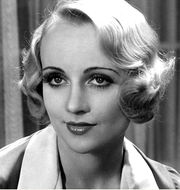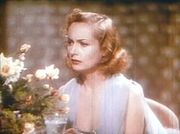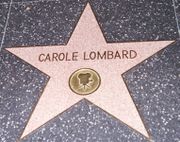Carole Lombard
| Carole Lombard | |
|---|---|
 |
|
| Born | Jane Alice Peters October 6, 1908 , U.S. |
| Died | January 16, 1942 (aged 33) Mount Potosi, near , U.S. |
| Occupation | Actress |
| Years active | 1921–1942 |
| Spouse | William Powell (1931–1933; divorced) Clark Gable (1939–1942; her death) |
Carole Lombard (October 6, 1908 – January 16, 1942) was an American actress.[1] She was particularly noted for her comedic roles in several classic films of the 1930s, most notably in the 1936 film My Man Godfrey. She is listed as one of the American Film Institute's greatest stars of all time and was the highest-paid star in Hollywood in the late 1930s, earning around US$500,000 per year (more than five times the salary of the US President). Lombard's career was cut short when she died at the age of 33 in the crash of TWA Flight 3.
Contents |
Ancestry and early life
Lombard was born Jane Alice Peters in Fort Wayne, Indiana. Her parents were Frederick C. Peters (1875-1935) and Elizabeth Knight (1877-January 16, 1942). Her paternal grandfather, John Claus Peters, was the son of German immigrants, Claus Peters and Caroline Catherine Eberlin. On her mother's side, she was a descendant of Thomas Hastings who came from the East Anglia region of England to the Massachusetts Bay Colony in 1634.[2] Lombard was the youngest of three children, having two older brothers. She spent her early childhood in a sprawling, two-story house at 704 Rockhill Street in Fort Wayne, near the St. Mary's River. Her father had been injured during his early life and was left with constant headaches which caused him to burst out in paroxysms of anger which disturbed the family. Her parents divorced and her mother took the three children to Los Angeles in 1914, where Lombard attended Virgil Jr. High School and then Fairfax High School. She was elected "May Queen" in 1924. She quit school to pursue acting full-time, but graduated from Fairfax in 1927.[3] Lombard was a second generation Bahá'í who formally enrolled in 1938.[4]
Career

Lombard made her film debut at the age of twelve after she was seen playing baseball in the street by director Allan Dwan; he cast her as a tomboy in A Perfect Crime (1921). In the 1920s, she worked in several low-budget productions credited as 'Jane Peters', and then later as 'Carol Lombard'. Her friend Miriam Cooper helped Lombard land small roles in her husband Raoul Walsh's films.[5] In 1925, she was signed as a contract player with Fox Film Corporation (which merged with Daryl Zanuck's Twentieth Century Productions in 1935). She also worked for Mack Sennett and Pathé Pictures. She became a well-known actress and made a smooth transition to sound films, starting with High Voltage (1929). In 1930, she began working for Paramount Pictures after having been dropped from both Twentieth Century and Pathé.
Lombard was originally given roles that would help to bolster the reputations of her leading men. It was not until 1934 that her career began to take off. That year, director Howard Hawks noticed that Lombard had something that perhaps had not been unleashed on film. He hired her for his next film, Twentieth Century, alongside stage legend John Barrymore. Lombard was at first terrified to be working alongside such a star and it was not until Hawks took her aside and threatened to fire her that she permitted her fiery personality to show on the screen. The film brought Lombard a level of fame.
That same year, she also starred in Bolero with George Raft and it was for this film that she turned down the role of Ellie Andrews in It Happened One Night.[6] The following year she starred in Mitchell Leisen's Hands Across the Table which helped to establish her reputation as a top comedy actress. 1936 proved to be a big year for Lombard with her casting in the screwball comedy My Man Godfrey alongside ex-husband William Powell. Her performance earned Lombard an Academy Award nomination for Best Actress. It was followed by Nothing Sacred in 1937, casting her opposite Fredric March and under the direction of William A. Wellman. It was Lombard's only film in Technicolor.
In 1938, Lombard suffered a flop with Fools for Scandal and moved on to dramatic films for the next few years. In 1939, Lombard was keen on being cast as Scarlett O'Hara in the epic Gone with the Wind, but was not even tested for the part, whereas her new husband, Clark Gable, was chosen to portray Rhett Butler. Instead, she took roles opposite James Stewart in Made for Each Other (1939) and Cary Grant in In Name Only (1939). She also starred in the dramatic Vigil in the Night (1940).
She then returned to comedy, teaming with director Alfred Hitchcock in Mr. & Mrs. Smith (1941). The film gave Lombard's career a much needed boost and she followed her success with what proved to be her last film, one of her most successful, To Be or Not to Be (1942).
Personal life
In October 1930, Lombard met William Powell. They worked together in the films Man of the World and Ladies' Man. Unlike many of Lombard's other suitors at the time, Powell was urbane and sophisticated and showed her a side of life she had not seen before. He also appreciated her blunt personality and bawdy sense of humor. They married on June 26, 1931.
Lombard commented to fan magazines that she did not believe their sixteen-year age difference would present a problem, but friends felt they were ill-suited, as Lombard had an extroverted personality while Powell was more reserved. They divorced in 1933, but remained good friends and worked together without acrimony, notably in My Man Godfrey.
In 1934, following her divorce from Powell, Lombard moved into a house on Hollywood Boulevard designed by friend William Haines. She lived with a friend from the days of Mack Sennett, Madalynne Fields, who became Lombard's personal secretary and whom Lombard called "Fieldsie." Lombard became known as one of Hollywood's great hostesses. She gave a party for friends in which she redecorated her home as a hospital operating room and had everyone come dressed as nurses and doctors while the food was delivered on a makeshift operating table and the guests ate with operating utensils; bedpans were reportedly used as dishes. It was during this time that Lombard began to relish being a party girl once more, carrying on relationships with actors Gary Cooper and George Raft, as well as the screenwriter Robert Riskin who proposed to Lombard in 1935. She turned down the offer, unable to marry a man who did not want to have children.
However, one man stood out to Lombard in particular. While on a date with Riskin, Lombard spotted the crooner Russ Columbo and they began a serious affair, which reportedly led to Columbo proposing marriage. Unfortunately, Columbo died when he was visiting a friend who collected antique pistols. While he was admiring a pistol, it went off and the bullet ricocheted and landed in Columbo's skull. To reporters, Lombard said Columbo was the love of her life.
Following the death of Columbo, Lombard hosted one last party, which was supposed to be her final party as one of Hollywood's most extravagant hostesses. She rented an amusement park for a day and invited almost every person she had ever come in contact with. Following the party, Lombard's gatherings were far more intimate and generally less extravagant.
Lombard's most famous relationship came in 1936 when she became involved with actor Clark Gable. They had worked together previously in 1932's No Man of Her Own, but at the time Lombard was still happily married to Powell and Gable already had more women than he was willing to deal with. They were indifferent to each other on the set and did not keep in touch.
It was not until 1936, when Gable came to the Mayfair Ball that Lombard had planned, that their romance began to take off. It was said that Gable and Lombard danced all night before disappearing. The disappearance, however, did not go further than driving around the block a few times. Lombard infuriated Gable and they did not speak to each other for the remainder of the evening. The following morning, Lombard sent Gable peace doves and their relationship took off in earnest. They had to be quiet about it, as Gable was still married to Ria Langham and a divorce would have cost him a fortune.
It was when a scandalous article called "Hollywood's Unmarried Husbands and Wives" was printed in a fan magazine that chief censor Will H. Hays went to Louis B. Mayer and demanded he do something about contract stars Gable and Robert Taylor, who had been mentioned in the article, Taylor for his relationship with Barbara Stanwyck. They were given a choice: marry the women or end their relationships. Both took the former route.
This proved a major factor in Gable accepting the role of Rhett Butler in Gone With the Wind, as Selznick wanted Gable so badly for the part that he was willing to pay almost any price. Gable accepted the salary, but it still was not enough to keep him from losing the majority of his fortune. He divorced Langham on March 7, 1939 and proposed to Lombard in a telephone booth at the Brown Derby.
During a break in production on Gone With the Wind, Gable and Lombard were married on March 29. They bought a ranch previously owned by director Raoul Walsh in Encino, California and lived a happy, unpretentious life. Although they attempted to have a child and Lombard stated that she was perfectly willing to give up her career to raise a family, their efforts were ultimately unsuccessful. Lombard conceived once with Gable, but miscarried. Nevertheless, they called each other "Ma" and "Pa" and raised chickens and horses. To all who knew Gable, she was the love of his life.
Off-screen, Lombard was much loved for her unpretentious personality and well known for her earthy sense of humor and blue language. Friends of Lombard's included Alfred Hitchcock, Marion Davies, William Haines, Jean Harlow, Fred MacMurray, Cary Grant, Jack Benny, Jorge Negrete, William Powell, and Lucille Ball.

Death
When the US entered World War II at the end of 1941, Lombard traveled to her home state of Indiana for a war bond rally. Just before boarding the plane, Lombard addressed her fans, saying: "Before I say goodbye to you all, come on and join me in a big cheer! V for Victory!" On January 16, 1942, Lombard and her mother boarded a Transcontinental and Western Airlines DC-3 airplane to return to California. After refueling in Las Vegas, TWA Flight 3 took off and 23 minutes later, crashed into "Double Up Peak" near the 8,300-foot (2500 m) level of Mount Potosi, 32 miles (52 km) southwest of Las Vegas. All aboard, 19 passengers and three crew, were killed.
Shortly after her death at the age of 33, Gable (who was inconsolable and devastated by her loss) joined the United States Army Air Forces. After officers training, Gable headed a six-man motion picture unit attached to a B-17 bomb group in England to film aerial gunners in combat, flying five missions himself. Gable attended the launch of the Liberty ship SS Carole Lombard, named in her honor, on January 15, 1944.
On January 18, 1942, Jack Benny did not perform his usual program, both out of respect for Lombard and grief at her death. Instead, he devoted his program to an all-music format.
Lombard's final film, To Be or Not to Be (1942), directed by Ernst Lubitsch and co-starring Jack Benny, a satire about Nazism and World War II, was in post-production at the time of her death. The film's producers decided to cut the part of the film in which her character asks, "What can happen on a plane?" as they felt it was in poor taste, given the circumstances of Lombard's death.
At the time of her death, Lombard had been scheduled to star in the film They All Kissed the Bride; when production started, her role was given to Joan Crawford. Crawford donated all of her pay for this film to the Red Cross.
Lombard is interred at the Forest Lawn Memorial Park Cemetery in Glendale, California. The name on her crypt marker is "Carole Lombard Gable". Although Gable remarried, he was interred next to her when he died in 1960. He always felt responsible for her death. Her mother, Elizabeth Peters, who also perished in the plane crash that killed her daughter, was interred on the other side of her.
Awards and honors

In 1999, the American Film Institute ranked Lombard 23rd on its list of the 50 greatest American female screen legends. She received one Academy Award for Best Actress nomination, for My Man Godfrey. She has a star on the Hollywood Walk of Fame, at 6930 Hollywood Blvd.
Lombard's Fort Wayne childhood home has been designated a historic landmark. The city named the nearby bridge over the St Mary's River the "Carole Lombard Memorial Bridge."
Portrayals
She has been played by:
- Jill Clayburgh in Gable and Lombard (1976)
- Sharon Gless in Moviola: The Scarlett O'Hara War (1980)
- Denise Crosby in Malice in Wonderland (1985)
- Anastasia Hille in RKO 281 (1999)
- Vanessa Gray in Lucy (2003)
Filmography
Features
- A Perfect Crime (1921)
- Gold Heels (1924)
- Dick Turpin (1925)
- Marriage in Transit (1925)
- Gold and the Girl (1925)
- Hearts and Spurs (1925)
- Durand of the Bad Lands (1925)
- The Plastic Age (1925)
- Ben-Hur (1925)
- The Road to Glory (1926)
- The Johnstown Flood (1926)
- The Fighting Eagle (1927)
- My Best Girl (1927)
- The Divine Sinner (1928)
- Power (1928)
- Me, Gangster (1928)
- Show Folks (1928)
- Ned McCobb's Daughter (1928)
- High Voltage (1929)
- Big News (1929)
- The Racketeer (1929)
- The Arizona Kid (1930)
- Safety in Numbers (1930)
- Fast and Loose (1930)
- It Pays to Advertise (1931)
- Man of the World (1931)
- Ladies' Man (1931)
- Up Pops the Devil (1931)
- I Take This Woman (1931)
- No One Man (1932)
- Sinners in the Sun (1932)
- Virtue (1932)
- No More Orchids (1932)
- No Man of Her Own (1932)
- From Hell to Heaven (1933)
- Supernatural (1933)
- The Eagle and the Hawk (1933)
- Brief Moment (1933)
- White Woman (1933)
- Bolero (1934)
- We're Not Dressing (1934)
- Twentieth Century (1934)
- Now and Forever (1934)
- Lady by Choice (1934)
- The Gay Bride (1934)
- Rumba (1935)
- Hands Across the Table (1935)
- Love Before Breakfast (1936)
- The Princess Comes Across (1936)
- My Man Godfrey (1936)
- Swing High, Swing Low (1937)
- Nothing Sacred (1937)
- True Confession (1937)
- Fools for Scandal (1938)
- Made for Each Other (1939)
- In Name Only (1939)
- Vigil in the Night (1940)
- They Knew What They Wanted (1940)
- Mr. & Mrs. Smith (1941)
- To Be or Not to Be (1942)
Short subjects
- Smith's Pony (1927)
- Gold Digger of Weepah (1927)
- The Girl from Everywhere (1927)
- Run, Girl, Run (1928)
- The Beach Club (1928)
- Smith's Army Life (1928)
- The Best Man (1928)
- The Swim Princess (1928)
- The Bicycle Flirt (1928)
- The Girl from Nowhere (1928)
- His Unlucky Night (1928)
- Smith's Restaurant (1928)
- The Campus Vamp (1928)
- Motorboat Mamas (1928)
- Hubby's Weekend Trip (1928)
- The Campus Carmen (1928)
- Matchmaking Mamma (1929)
- Don't Get Jealous (1929)
- Hollywood on Parade No. 11 (1933)
- Hollywood on Parade No. A-12 (1933)
- The Fashion Side of Hollywood (1935)
- Screen Snapshots Series 16, No. 3 (1936)
- Breakdowns of 1938 (1938)
- Hollywood Goes to Town (1938)
- Screen Snapshots Series 18, No. 9 (1939)
References
- ↑ Obituary Variety, January 21, 1942, page 54.
- ↑ Willard, J., Walker, C.W., Pope, C.H., Willard Genealogy, Sequel to Willard memoir, Boston: Willard Family Association, 1915, 212.
- ↑ Carole Lombard Biography - CaroleLombard.org
- ↑ The Bahá'í World 1940-1944 p.635. Bahá'í Publishing Trust, Wilmette.
- ↑ Cooper, Miriam (1973). Dark Lady of the Silents. Bobbs Merrill. pp. 11, 216–217. ISBN 0-672-51725-6.
- ↑ MacBride, Joseph. Frank Capra, The Catastrophe of Success. New York: St. Martin's Griffin, 2000. P. 303. ISBN.